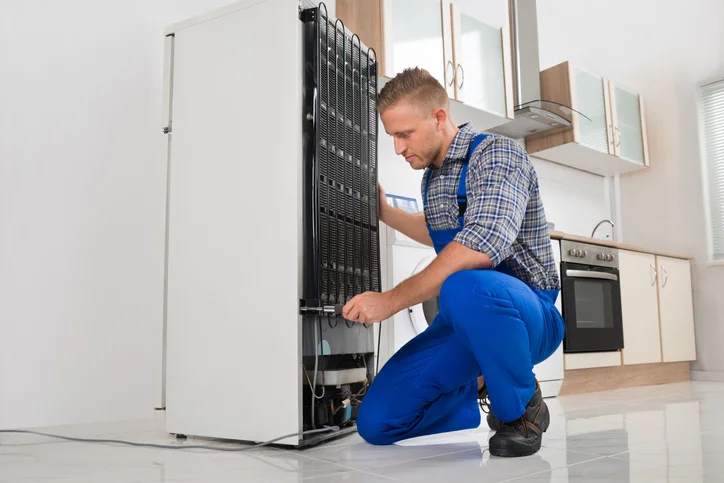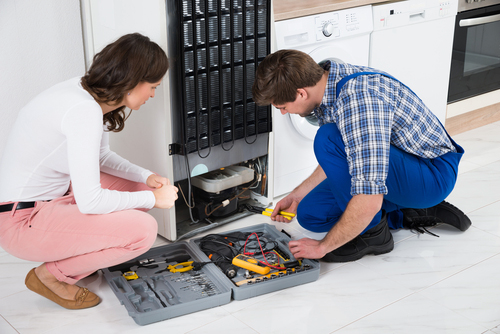Appliance Repair Oro Valley Dependable Appliance Services Reveals the Top 5 Mistakes Homeowners Make When Ignoring Small Appliance Issues
Appliance Repair Oro Valley Dependable Appliance Services Reveals the Top 5 Mistakes Homeowners Make When Ignoring Small Appliance Issues
Blog Article
Crucial Tips for Effective Ref Repair Work to Prolong Device Lifespan
When it comes to your fridge, appropriate repair and maintenance are important for durability. Recognizing typical troubles and knowing when to act can make all the difference.
Comprehending Typical Fridge Issues
Fridges are important in maintaining your food fresh, but they can encounter a series of common troubles that interrupt their efficiency. One frequent issue is poor air conditioning. If you observe food spoiling quicker than typical, check the thermostat setups or take into consideration if the door seals are damaged. Another usual trouble is extreme noise, which can suggest a malfunctioning compressor or a stopping working fan. You could also experience water pooling inside or underneath the refrigerator; this commonly results from a clogged defrost drainpipe or a malfunctioning water line. Furthermore, if your fridge's light isn't functioning, it might be an easy light bulb problem or a problem with the door button. Finally, ice build-up in the freezer can impede air flow and cooling performance. Identifying these problems early can save you money and time out of commission, guaranteeing your fridge runs smoothly and efficiently.
Normal Maintenance Practices
To keep your devices running efficiently, you need to remain on top of normal maintenance practices. Tidy the condenser coils, examine the door seals, and monitor the temperature setups to guarantee peak performance. These basic jobs can conserve you money and time on repair services down the line.
Tidy Condenser Coils Regularly
Cleansing your condenser coils on a regular basis can greatly boost your device's effectiveness. Dust and dirt construct up on these coils over time, triggering your home appliance to work harder and eat even more energy. To keep them tidy, unplug your appliance and carefully eliminate any protective covers.
Inspect Door Seals
Three straightforward steps can aid you ensure your home appliance's door seals remain in great condition. Examine the seals regularly for any type of cracks, splits, or indicators of wear. These problems can result in air leaks, affecting effectiveness. Second, tidy the seals making use of warm, soapy water to get rid of any debris or gunk. A clean seal assures a tight fit and better performance. Lastly, do a basic examination by closing the door on a notepad. If you can easily draw it out without resistance, the seal might require changing. By adhering to these actions, you'll keep your device's performance and long life, conserving you money on energy bills and repair work in the long run.
Display Temperature Level Setups
Consistently checking your device's temperature level setups is vital for finest performance and efficiency. Whether you're handling a fridge, fridge freezer, or stove, maintaining an eye on these setups can prevent several problems. For fridges, go for temperature levels between 35 ° F and 38 ° F; for fridges freezer, stick around 0 ° F. If the temperatures are too expensive or low, your appliance may function harder, wasting energy and shortening its lifespan. Make use of a thermostat to inspect these setups regularly, specifically after major adjustments, like moving your device or adjusting the thermostat. If you observe fluctuations, readjust the settings appropriately and speak with the customer manual for advice. By staying positive about temperature surveillance, you'll ensure your devices run smoothly and last much longer.
Troubleshooting Cooling Problems
When your refrigerator isn't cooling properly, it can cause spoiled food and wasted money, so dealing with the problem without delay is essential. Beginning by checking the temperature level settings to validate they're at the suggested degrees, typically around 37 ° F for the fridge and 0 ° F for the fridge freezer. If the settings are appropriate, check the door seals for any type of gaps or damages; a defective seal can allow warm air to enter.
Next, analyze the vents inside the fridge and freezer. Validate my response they're not blocked by food things, as this can interfere with air movement. Pay attention for the compressor; if it's not running or making uncommon sounds, it may need attention. Inspect the condenser coils, typically located at the back or bottom of the unit. Dust and debris can collect, triggering cooling issues. Tidy them with a vacuum cleaner or brush to enhance performance. If problems linger, it could be time to call a specialist.
Dealing With Water Leak and Ice Accumulation
If you're handling water leakage or ice accumulation in your device, it's vital to recognize the resource of the issue. By determining where the water is coming from, you can avoid further issues and stay clear of expensive repair work. Let's explore some reliable approaches to tackle these typical issues.
Recognize Leakage Resources
Just how can you efficiently recognize the sources of water leakage and ice accumulation in your devices? Start by examining the seals and gaskets on your fridge and fridge freezer doors. By methodically checking these areas, you'll pinpoint the resource of the issue, permitting you to take the essential steps to fix it and extend your home appliance's lifespan.
Protect Against Ice Development
To stop ice development in your home appliances, beginning by verifying the temperature level setups are proper. If your refrigerator or freezer is too cold, it can result in extreme ice build-up. Check the door seals consistently; harmed seals can allow warm air in, triggering condensation and navigate to this website ice formation.
Keep the device well-ventilated and stay clear of congestion, as this can obstruct airflow - Washing Machine Repair Dependable Refrigeration & Appliance Repair Service. Consistently defrost your fridge freezer if it does not have an automatic defrost function.
If you discover water leak, determine and fix any obstructed drain openings, as they can add to ice accumulation. Ultimately, clean the coils and verify they're working appropriately to preserve peak performance. Taking these steps will help expand your home appliance's life expectancy and efficiency.
Dealing With Noisy Refrigerator Sounds
While it might seem disconcerting, a noisy fridge often signals small issues rather than significant breakdowns. Determine the source of the sound. Typical wrongdoers include the compressor, followers, and water lines. If you listen to a buzzing sound, it may be the compressor working hard; this can just be a normal operation sound.
Following, look for loose items inside. Often, containers or racks can rattle, creating unwanted noise. Tighten up or rearrange them to eliminate the audios.
If you notice a clicking noise, it could be the defrost timer. This is normally safe yet can indicate it requires inspection.
Finally, verify your refrigerator is degree. An out of balance appliance can generate vibrations and noise. Utilize a level to examine, and adjust the feet if needed. Attending to these problems quickly can assist maintain your refrigerator's performance and lengthen its life-span.
When to Replace Parts vs. Complete Replacement

Nonetheless, if your home appliance is older and experiencing numerous problems, a complete substitute could be a lot more economical. Consider the price of repair services versus the home appliance's value. If repair services surpass 50% of a brand-new device's price, it's typically smarter to purchase a substitute. Additionally, if you discover recurring issues that keep persisting, it's a sign that your device has gotten to completion of its life. Weigh these factors carefully to make the very best choice for your demands and spending plan.
Recognizing When to Call an Expert
Exactly how can you inform when it's time to call in a professional for home appliance fixing? If your appliance quits functioning completely or regularly journeys circuit breakers, it's an additional red flag.
You need to likewise consider your own comfort degree with fixings. If you're unclear regarding identifying the issue or lack the right devices, it's ideal to connect for aid. Bear in mind, trying difficult fixings can cause even more damages or also security dangers.

Regularly Asked Inquiries
Just how Often Should I Clean the Refrigerator Coils?
You need to clean your fridge coils every 6 months. This helps preserve performance and avoids getting too hot. If you notice extreme dirt or pet hair, clean them a lot more regularly to guarantee your fridge runs efficiently.

Can I Make Use Of Vinegar for Cleaning My Fridge?
Yes, you can make use of vinegar to cleanse your refrigerator! It's an exceptional all-natural cleaner that removes odors and spots. Washing Machine Repair Dependable Refrigeration & Appliance Repair Service. Just blend it with water, apply it to surface areas, and clean down for a fresh, clean fridge
What Temperature level Should My Refrigerator Be Ready To?
You must set your fridge to 37 ° F(3 ° C) for ideal food click over here now preservation. This temperature level maintains your food fresh while avoiding putridity, guaranteeing your grocery stores last much longer and reducing waste. It's an easy adjustment you can make!
Does a Refrigerator Need to Be Leveled?
Yes, your fridge requires to be leveled. If it's unequal, it can affect cooling performance and create excess noise. Examine the leveling legs and readjust them to ensure appropriate balance for ideal efficiency.
Exactly How Can I Reduce Fridge Energy Consumption?
To minimize your fridge's power intake, keep it clean and well-ventilated, inspect door seals for leakages, established the temperature in between 35-38 ° F, and prevent straining it. These actions can significantly reduce your energy costs.
Report this page